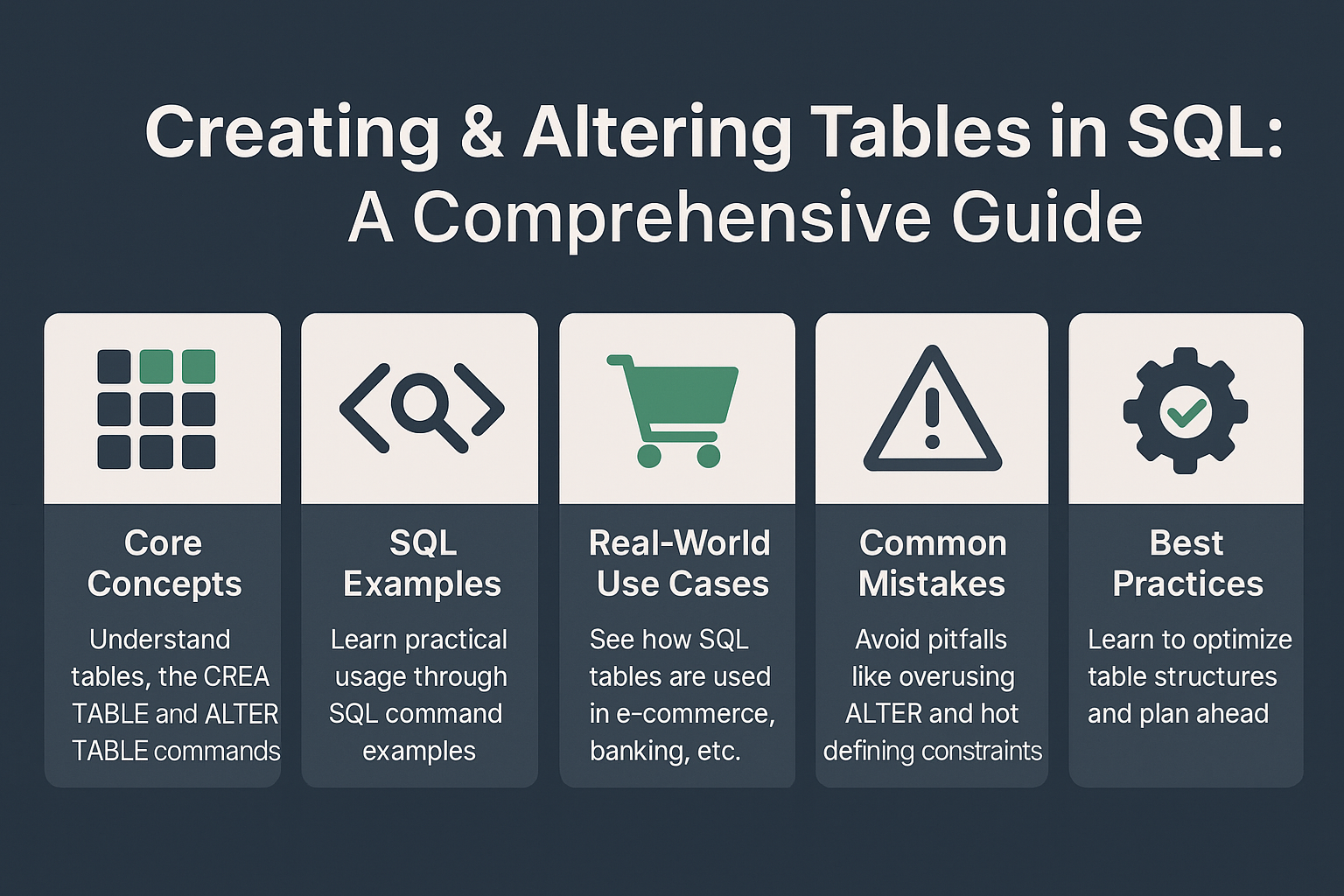Introduction
Tables are the foundation of relational databases, storing data in rows and columns. Understanding how to create and modify tables is essential for database developers and administrators.
Why It Matters
- Create Tables: Define data structures for your applications.
- Alter Tables: Adapt schema as requirements evolve.
Real-world analogy:
Creating a table is like building a new apartment floor plan. Altering a table is like renovating an existing apartment by adding or removing rooms.
Core Concepts
What is a Table?
A table is a structured collection of data organized into rows (records) and columns (attributes).
CREATE TABLE Command
Used to define a new table with columns, data types, and constraints.
ALTER TABLE Command
Used to modify an existing table, such as adding or removing columns or constraints.
SQL Examples
Creating a Basic Table
CREATE TABLE customers (
customer_id SERIAL PRIMARY KEY,
name VARCHAR(50) NOT NULL,
email VARCHAR(100) UNIQUE,
signup_date DATE DEFAULT CURRENT_DATE
);
Adding a Column
ALTER TABLE customers
ADD phone VARCHAR(15);
Modifying a Column
ALTER TABLE customers
ALTER COLUMN name TYPE VARCHAR(100);
Dropping a Column
ALTER TABLE customers
DROP COLUMN phone;
Adding a Constraint
ALTER TABLE customers
ADD CONSTRAINT email_unique UNIQUE (email);
Real-World Use Cases
- E-commerce: Creating tables for customers, products, and orders.
- Banking: Managing accounts, transactions, and users.
- Healthcare: Storing patients, appointments, and medical records.
Common Mistakes and Anti-Patterns
- Using SELECT * without schema planning: Leads to future refactoring issues.
- Overusing ALTER TABLE in production: Can cause downtime or locking issues.
- Not defining constraints: Leads to data inconsistency.
Performance and Scalability Implications
- Creating tables is lightweight; altering large tables can lock rows and impact performance.
- Adding indexes improves queries but slows down inserts/updates.
- Use partitioning for very large tables.
RDBMS Comparison
| Feature | PostgreSQL | MySQL | Oracle |
|---|---|---|---|
| Auto Increment | SERIAL | AUTO_INCREMENT | SEQUENCE |
| Alter Column Type | Fully supported | Limited (requires cast) | Supported |
| Adding Columns | Online in v12+ | Online in 8.0+ | Fully supported |
Best Practices & Optimization Tips
- Plan table structure carefully to minimize future alterations.
- Always define primary keys and appropriate constraints.
- Use descriptive column names for readability.
- Test ALTER TABLE operations in staging before production.
- Use transaction blocks to rollback in case of errors.
When to Use vs When to Avoid
Use CREATE TABLE When:
- Designing a new database schema.
- Starting new projects or adding entities.
Use ALTER TABLE When:
- Requirements change and schema needs updates.
Avoid Excessive ALTER When:
- Frequent changes cause downtime; plan schema design upfront.
Conclusion & Key Takeaways
Creating and altering tables are essential database operations. Proper planning, use of constraints, and testing ensure robust, scalable, and maintainable schemas.
Key Points:
- CREATE TABLE defines new structures.
- ALTER TABLE adapts existing structures.
- Always plan ahead to minimize costly schema changes.
FAQ
1. What is the basic syntax for CREATE TABLE?CREATE TABLE table_name (column definitions);
2. How do I add a column to an existing table?
Use ALTER TABLE table_name ADD column_name datatype;
3. Can I drop multiple columns at once?
Yes, separate them with commas in DROP COLUMN in some RDBMS.
4. Does ALTER TABLE lock the table?
Depends on the RDBMS and operation; large changes may lock rows.
5. Can I rename a table?
Yes, use ALTER TABLE table_name RENAME TO new_name;
6. What’s the difference between ALTER COLUMN and MODIFY COLUMN?
PostgreSQL uses ALTER; MySQL uses MODIFY for data type changes.
7. How to avoid downtime during ALTER TABLE?
Use online schema changes or perform during maintenance windows.
8. Should every table have a primary key?
Yes, for data integrity and efficient joins.
9. Can I change a column’s data type later?
Yes, but may require data migration.
10. Which RDBMS handles ALTER TABLE best?
PostgreSQL and Oracle support robust ALTER operations; MySQL has improved in v8.0.
